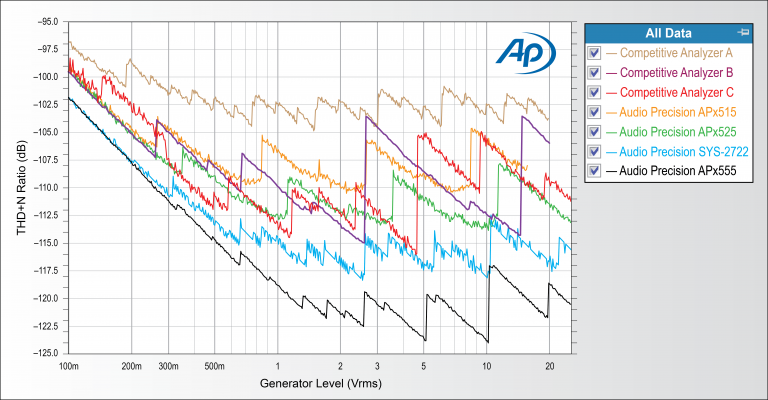
For loudspeakers, frequency response is also the basis from which another important metric, sensitivity, is derived. Sensitivity is a measure of the output from the device per unit input. For example, a loudspeaker system with a specification of “94 dB SPL, 1 W/1 m” indicates that for an input of 1 watt, it will output a sound pressure level of 94 dB at a distance of one meter. For loudspeakers, sensitivity is calculated by averaging the frequency response magnitude over a range of frequencies, because they typically do not have flat frequency response.
Because frequency response is such an important audio quality metric, audio analyzers have several different ways of measuring it. For example, some of the measurements available in Audio Precision audio analyzers that could be considered for smart speaker testing include:
• Stepped sine sweep.
• Logarithmically-swept sine (chirp).
• Multitone.
• Transfer Function.
Each measurement technique has certain advantages and disadvantages with respect to measuring the primary input and output paths of a smart speaker.
Stepped Sine Sweep
Stepped sine testing is the classic means of measuring frequency response that has been in use since the earliest days of audio test, even before audio analyzers existed. It involves testing a DUT by “sweeping” over a series of discrete frequency steps within the frequency range of interest – usually some portion of the audible frequency range, considered to be 20 Hz to 20 kHz. At each frequency step, the device is stimulated with a sine wave and its output is analyzed to determine metrics such as level and harmonic distortion.
In general, one advantage of stepped sine testing over other techniques is that because of its long history of use, it is often considered to be a type of “gold standard” against which other techniques may be compared if there is any doubt about measurement integrity. Another advantage is that other audio quality metrics such as total harmonic distortion (THD) and inter-channel phase can be measured at the same time as frequency response.

A general disadvantage of stepped sine testing is test time. Devices often have a transient response when the stimulus frequency is changed abruptly, requiring more time at each step for the device to settle to its steady-state behavior. Another related disadvantage is poor frequency resolution. Because the frequency steps are discrete, higher resolution requires more steps which increases test time.
For acoustic devices, one of the biggest disadvantages of stepped sine testing is that a test environment free of reflections (usually an anechoic chamber) is required. An ordinary room with reflective surfaces can’t be used because reflected sound waves will combine (either constructively or destructively) with the direct sound waves of interest, causing severe measurement errors. For testing the input path of a smart speaker, stepped sine testing has two additional disadvantages:
- Smart speakers are designed to capture and process speech signals. It’s therefore quite likely that they will have digital signal processing (DSP) designed to attenuate sinusoidal signals. It might be difficult to effectively test this path with a stepped sine signal unless this feature can be disabled for the test.
- When conducting an end-to-end test, there is a limit to the length of signal the device will record when attempting to process speech commands (e.g., approximately 7 seconds, including the keyword, in the case of the Alexa IVA service). In this case, a stepped sine stimulus would have to be less than about 6 seconds long.
Stepped sine testing works well for testing the output path of a smart speaker, provided the test environment is anechoic within the frequency range of interest.
Logarithmically-Swept Sine
The log-swept sine technique (sometimes called chirp or continuous sweep) was introduced in 2000. [8] It uses a type of sinusoidal stimulus in which the frequency is continuously swept logarithmically from low to high frequency in a short time (from a fraction of a second to a few seconds). Log-swept sine testing is very popular in audio test because it can be used to derive a number of audio quality metrics, including THD and individual components of harmonic distortion with a short test time.
Log-swept sine testing has some additional advantages for acoustic measurements:
- Because the frequency response is derived from the impulse response, the analysis can make use of what is known as a “time-selective” or “quasi-anechoic” technique. Before calculating the frequency response, the end of the impulse response is windowed to remove the effect of room reflections. Although this reduces the accuracy of the measurement at lower frequencies, if used carefully, it can enable accurate measurements of the mid to upper frequency range response of an acoustic device without the need for an expensive anechoic chamber.
- In AP’s APx500 audio analyzers, the log-swept sine measurement designed for acoustic testing, (known as “Acoustic Response”) can be used to detect rub and buzz defects in loudspeakers.
The log-swept sine technique can be employed to test the input path of a smart speaker. However, the signal is still a type of sinusoid, so care should be taken when testing devices in which the DSP intended to block pure tones can’t be disabled. For example, it might be necessary to use a short sweep, so the system does not have enough time to recognize and react to the fact that a sinusoidal signal is present.
With its quasi-anechoic capability and optional ability to detect rub and buzz, the log-swept sine is an ideal stimulus for testing the output path of a smart speaker.
